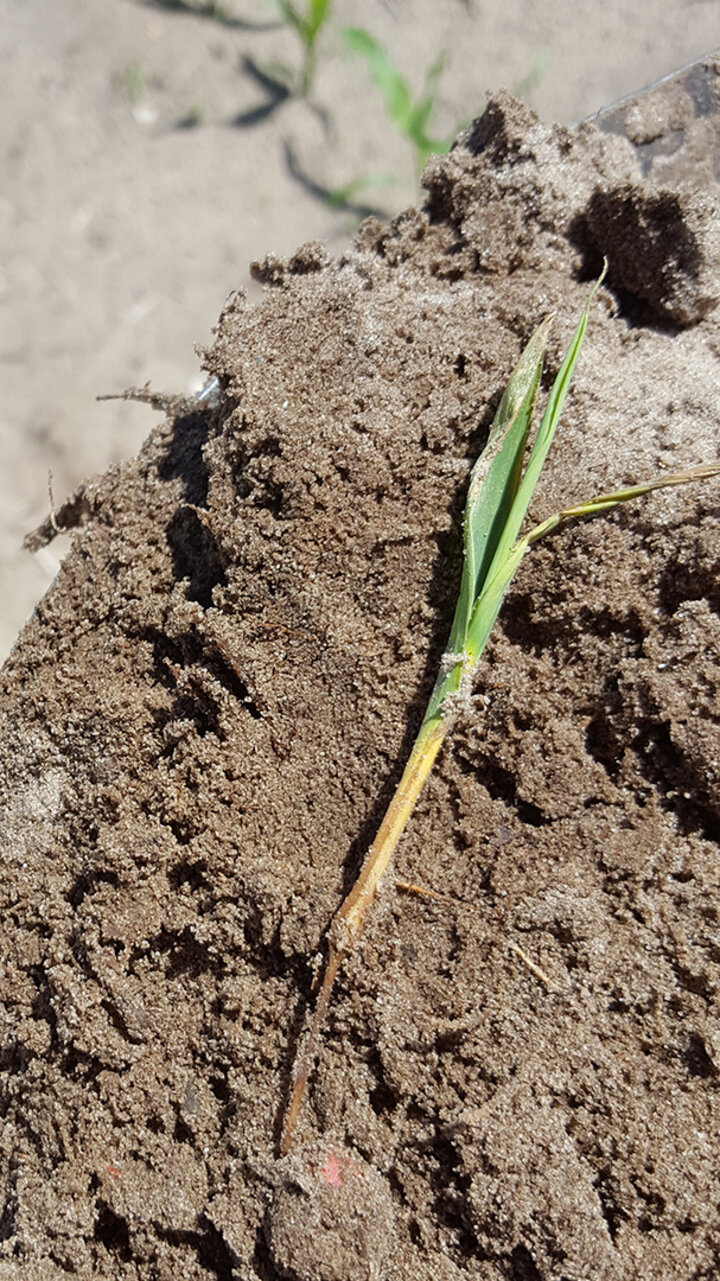Heavy rains and cool soils throughout the state may favor the development of seedling diseases, which could impact corn and soybean emergence. These conditions come at a poor time in crop development as they favor several of the most common and damaging seedling diseases. As these conditions continue, be sure to monitor seedling emergence and stand establishment to detect potential problems as early as possible.
Corn and soybean crops suffer from several common soil fungal and fungal-like organisms. These pathogens include Pythium, Fusarium and Rhizoctonia. Soybeans face an additional threat from the fungal-like organism Phytophthora.
While all four of these pathogens are common, they often result in some form of pre- or post-emergence damping off (Figures 1 and 2), which can be difficult to differentiate during diagnosis. Many management options may be the same for these pathogens, however, some seed treatments work best for control of specific pathogens. These symptoms are also easily confused with insect injury, herbicide damage, planting problems, or environmental stresses that often cause similar symptoms. A proper diagnosis may be beneficial for more targeted management in the next season.

Following are brief descriptions of corn and soybean seedling pathogens.
Pythium
Wet conditions are favorable for Pythium, which is our most common seedling disease of soybean in Nebraska. Cooler soil temperatures will make this worse as the seedling will be stressed and grow more slowly.
Typical symptoms of Pythium will include seed decay, pre-emergent seedling rot, and seedling damping off after emergence. If the plant has emerged, it often can have a root system where the outer layer can be easily pulled off and the center of the root will stay intact. In corn, dark lesions may develop on the mesocotyl or root system.
Rhizoctonia Root Rot
Rhizoctonia is favored by drier conditions and will occur more commonly in sandy or well-drained loamy soil types. On soybeans and corn, Rhizoctonia will be evident as reddish-brown lesions on the lower stem (typically at the soil level). In corn, seedlings may die and rot below the soil surface. These plants are often characterized by water-soaked and dark mesocotyl tissue that can be removed revealing the white inner vascular tissue.
Fusarium Root Rot
Fusarium is commonly favored by dryer conditions and in sandy or well-drained loamy soil types. Infected soybean crops will have stunted plants with brown to black discoloration on the roots (often in the lower portion of the root system). In corn, root systems may appear small with brown to black discoloration.
Phytophthora – Soybean Only
As soil conditions warm up, Phytophthora often will become more common with heavy rains. Fields will typically have a history of this disease, which will flare up when rain events saturate soil profiles. Phytophthora is often culpable when a field was planted with a standard rate of seed treatment but still has significant stand reduction when wet conditions occur. This will be a field-specific issue and usually does not occur as often as Pythium.

Typical symptoms of Phytophthora are seed decay and pre-emergence seedling rot, and seedling damping off after emergence. Typical symptoms on seedlings are darkened stems at the base of the plant coming up from the soil line (Figure 3). When young plants are cut at the lower stem, often there will be a dark center to the stem. Phytophthora can kill plants at any stage of development, but Pythium typically does not kill plants much past the V5 growth stage.
Management
Management of seedling diseases can be achieved by improving field conditions for seedlings. Improving drainage of low-lying wet areas can help reduce the incidence and severity of some seedling diseases. Another option is delaying planting until more favorable conditions exist for rapid germination and emergence. However, delaying planting too long can negatively impact yield potential.
The most common method for disease management is the use of seed treatment fungicides. Most seed corn is already treated with more than one seed treatment fungicide — often an insecticide — and sometimes with a nematicide. These products can provide protection against some of the pathogens that cause seedling diseases; however, they only provide protection during the first few weeks immediately after planting. Despite their activity, diseases may still develop, such as during extended periods of inclement weather or under severe pathogen pressure. Often greater seed treatment options are available for soybeans as they are not pre-treated. This allows more specific targeting of the pathogen and emphasizes why a proper diagnosis is important.
Some fungicides now also are labeled for application at planting, in or near the seed furrow. Use of fungicides at planting may provide some additional protection against these and other pathogens, but more research needs to be conducted to better predict their potential benefits, interactions and potential economic return.
You can minimize the likelihood of developing seedling diseases by planting high quality seed at appropriate planting depths and soil conditions to support rapid plant growth and emergence.
For more information on corn or soybean diseases, please visit the CropWatch Disease Management pages on corn and soybean.

